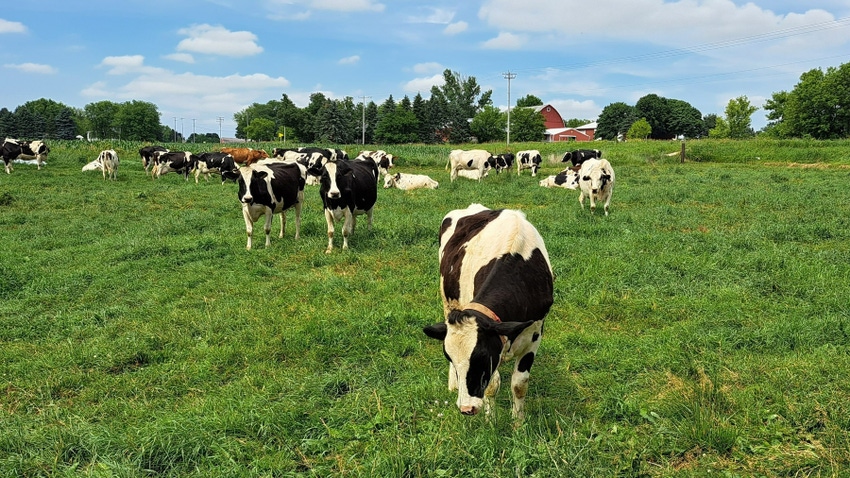August 30, 2023

by Alison Pfau
The contribution of the dairy production system to climate change is small compared to electricity generation or transportation (see graphic below). A 2022 report from U.S. EPA shows the agriculture sector’s contribution to total greenhouse gas emissions in the U.S was around 10% on a million metric tons of carbon dioxide equivalent.
Methane is a GHG that has 28 times the warming potential of carbon dioxide and is an area of concern in animal agriculture. Despite ag’s small contribution, dairy production systems are positioned to be an essential part of the solution by developing strategies to reduce GHG. The reduction of methane emissions by the dairy industry is critical because it could result in a nearly immediate mitigation of the warming impacts, due to the short lifetime of the methane in the atmosphere.
Methane is produced in livestock due to the unique ecosystem of the rumen that provides an ideal environment to maintain different populations of microorganisms, including those that produce methane.

Some of the most popular additive inhibitors are 3-nitrooxypropanol (3-NOP) and red seaweed. The rumen fermentation modifiers, on the other hand, lead to favorable changes in the rumen environment, improving animal productivity, health and efficiency, and increasing the availability of dietary protein for the animal by protecting the protein from microbes’ utilization. These fermentative modifier additives are composed of ionophores, tannins and essential oils. Some of these inhibiting or modifying feed additives are commercially available, while others are still in the research stage.
3-NOP. Often commercially sold as Bovaer, 3-NOP is approved for use in Europe, some Latin American countries and other countries around the world. In the U.S., the use of 3-NOP has not been approved yet by the Food and Drug Administration.
Different studies have shown an effective reduction of methane of 28% to 36% in dairy cattle, as well as an increase in milkfat content of 0.19%, or 0.21 pound per day, by feeding animals about 123 grams of 3-NOP per day. A 50% reduction in methane production was also seen in beef cattle. These results are positive in terms of mitigation of gases, and will impact the future acceptance and implementation of these synthetic additives by dairy and beef producers.
Red seaweed. Seaweeds are macroalgae and multicellular organisms that grow in marine and freshwater environments. In recent studies, the red algae called Asparagopsis taxiformis has shown to be highly effective at reducing methane emissions in vitro and in vivo, without negatively affecting forage digestibility. Several studies demonstrated the reduction of methane production per kilogram of dry matter intake of up to 55% in dairy cattle and around 98% in beef cattle.
However, the use of A. taxiformis in dairy cattle showed some residue of iodine and bromide concentrations in the milk. Consequently, more research is necessary on recommended dosage, as well as the impacts of these seaweeds on animal performance and health.
Ionophores. Ionophores such as lasalocid, monensin, salinomycin, laidlomycin and narasin are antibiotics used in cattle to modify ruminal fermentation patterns to improve feed efficiency and performance. They target the bacteria producing acetate and butyrate from glucose. The production of acetate and butyrate results in a loss as a form of methane and heat, producing a loss of energy. Methane losses can represent up to 12% of the energy of the feed.
Different investigations show that monensin supplementation produced a modest reduction of methane production of 2% in dairy cattle and 15% in beef cattle. Ionophores are used extensively around the U.S. More than 90% of the feedlot systems where cattle are fed with high grain concentration in their diets use ionophores.
Tannins. Tannins are secondary metabolites of phenolic substances soluble in water, with variable chemical structure and molecular weight. One of the most recognized functions of tannins is the ability to bind to and denature proteins, reducing protein breakdown in the rumen by microbes. In relation to microbial and digestive enzymes, tannins exert an inhibitory effect, reducing organic matter, neutral detergent fiber and protein digestibility. For this reason, some classes of tannins have shown the potential for reducing methane emissions by 13% to 16% in dairy cattle.
However, the excess of tannins in the diet can cause less consumption of feed, due to the difficulty for cattle to digest these tannins, impacting animal performance.
Essential oils. Essential oils, like tannins, are volatile, aromatic, secondary metabolite compounds produced by plants, especially herbs and spices. One of the principal functions of essential oils is antiseptic and antimicrobial activity. Different studies demonstrate that the use of essential oils could decrease intra-ruminal nitrogen turnover and nitrogen excretion, slow degradation of starch-rich substrates, and inhibit methanogenesis.
The accomplishment of the ruminant production systems in the U.S. and around the world to reduce GHG emissions is tremendous. The results have led to improvements in animal performance and growing supply of milk while minimizing the environmental impact from the livestock GHG emissions. However, more research is necessary on these feed additives to understand the regulatory policy, feasibility of implementation and economic impact to dairy and beef producers.
Pfau is the University of Wisconsin Extension regional dairy educator for Dane, Dodge, Jefferson, Rock and Walworth counties.
Read more about:
MethaneYou May Also Like




